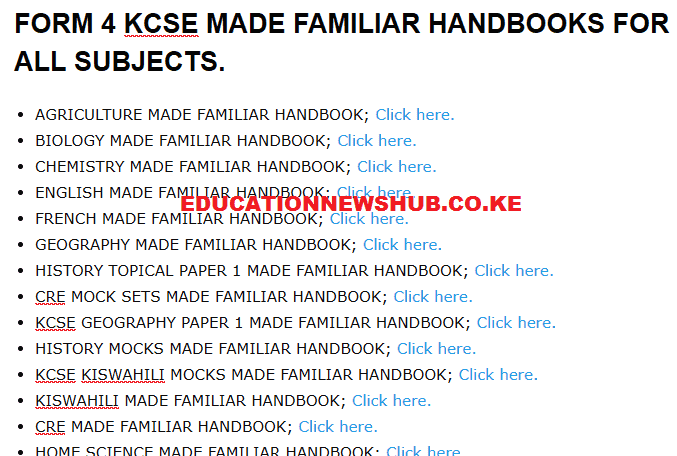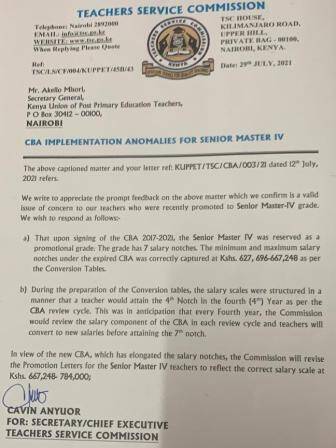CHRISTIAN RELIGIOUS EDUCATION
PAPER 1
MARKING SCHEMEME-2012
- (a) The literary forms used in the writing of the Bible
(i) Poetry
(ii) Wise sayings
(iii) Prose/narratives
(iv) Letters/Epistles
(v) Legal/Law expressions
(vi) Songs
(vii) Prophetic/ speeches
(viii) Gospels
(ix) Philosophical essays
(x) Prayers eg Nehemiah
- xi) Sermons (6×1=6 marks)
(b) Reasons why the Bible had to be compiled into its present form by early Christians.
(i) The eye witnesses of Jesus Christ were being killed.
- ii) In order to prevent information from getting lost/distorted
iii) Due to the expansion of the church/increased number of believers/who needed material to refer to.
iiv) To counteract false teachings/ teachers who were confusing the believers.
(v) To ensure that same doctrines/beliefs, were being taught to all Christians
- vi) To reach out to the Jews in Diaspora/ gentiles
vii) To preserve an orderly account of biblical themes/ distortion
(4×2= 8 marks).
(c) Ways in which Christians use the Bible in Kenya today.
(i) Christians read the Bible for spiritual growth/ meditation/ Bible study
(ii) They use it for instructing converts.
(iii) It is used as a text book when teaching Christian Religious Education in schools/colleges.
(iv) It is used as resource material in search of general knowledge.
(v) It is used to compose Christian hymns/ songs/ dramas/ plays/ films.
(vi) It is used in taking oaths/vows/swearing.
(vii) It is used as a prayer book
(viii) It is used for preaching evangelism
(ix) It is used to explain Christian ethics/ rituals/ doctrines.
- x) It is used to produce Christian literatures of Christian magazines
(6 x 1 = 6 marks)
Download free unlimited CRE resources below; Educationnewshub.co.ke:
CRE FORM 1 EXAMS WITH MARKING SCHEMES
CRE free lesson plans for all topics (Form one to four)
CRE NOTES FOR FORM ONE TO FOUR BOOKLET
KNEC CHRISTIAN RELIGIOUS EDUCATION, CRE, SYLLABUS
CRE Form 1-4 Notes and Exams (Free downloads)
CRE Topic By Topic Questions And Answers
CRE SCHEMES OF WORK FOR FORM ONE
CRE Notes and Exams for Form one to Four; Free Downloads

- a) The covenant ceremony between God and Abraham.
(i) Abraham was in doubt for the promise of a son.
(ii) God assured him that his own son would inherit him and not Eliezer of Damascus.
(iii) God showed Abraham the many stars and confirmed that his decedents would be as the stars.
(iv) God asked Abraham to bring him a heifer, a goat, a ram, each three years old, a dove and a young pigeon.
(v) Abraham cut the animals into and arranged the halves in two rows.
(vi) The birds were not cut.
(vii) He drove away the birds of prey that targeted the carcasses.
(viii) At sunset Abraham fell into a deep sleep.
(ix) God spoke to him giving the promise that his descendants would be slaves for four
hundred years but He would set to liberate them.
(x) Abraham was promised a long peaceful life. Good old age.
(xi) Abraham saw God pass through the carcasses in form of a smoking fire pot and a flarming torch.
xii) Reaffirmed to give them land.
(7x1=7marks)
- b) Differences between Jewish and the traditional African circumcision practices.
(i) In the Jewish community, it is for boys only while in some traditional African
communities it is for both boys and girls.
(ii) In the Jewish community, it is done on eighth day while in traditional African communities it is done during adolescent stage.
(iii) Its purpose in the Jewish community is to identify with God’s people while in traditional African communities it is to promote one to adult life.
(iv) Among the Jews, the practice was commanded by God while in traditional African communities it was done in obedience to the ancestors.
(v) The rite is not seasonal among the Jews as is the case in traditional African communities.
(v) In traditional African communities it is a gate way to more responsibilities while among the Jews one is too young for any responsibility.
(4×2= 8 marks)
- c) Reasons why church leaders in Kenya take vows before starting their mission.
(i) To receive God’s blessing/guidance.
(ii) To get acknowledgement from the people being served.
(iii) It reminds the leader to stick to the church regulations/mission.
(iv) To get the authority of God to lead.
(v) It gives the leader courage to do his/her work.
(vi) It shows one’s willingness/ commitment to serve.
(vii) To emulate the Biblical way of commissioning servants of God.
(5×1=5marks)
- (a) Ways used by King David to promote the workup of God in Israel.
(i) He brought the ark of the covenant to Jerusalem.
(ii) He made Jerusalem a holy city where Israelites from all over the land came for important religious occasion.
(iii) He composed the Psalms which were used in worship by the Israelites.
(iv) He showed respect to the prophets of Yahweh/listened to their messages.
(v) He wanted to build a temple for God/made preparations for its construction.
(vi) When he made mistakes, he asked for Yahweh’s forgiveness/repented.
(vii) He sought for God’s guidance in whatever he wanted to do
viii) He entered into a covenant with God.
- ix) He build alters / offered sacrifices
(6×1=6marks)
(b) Life skills used by Prophet Elijah to fight against false religion.
(i) Asseniyeness – he told Ahab that he was the cause of trouble in Israel.
(ii) Creative thinking – He requested for a contest between the prophets of Baal and himself.
(iii) Decision making -He killed the prophets/prophetess of baal.
(iv) Self esteem – He was convinced that God was on his side.
(v) Negotiation – Elijah asked the Israelites to choose between God and Baal.
(vi) Conflict resolution – Through the contest, he convinced the Israelites that Yahweh was the true God.
(vii) Effective communication – He explained to the people how the contest was to be carried out.
(viii) Self awareness – He knew that he was the prophet of the true God/ he had confidence in himself.
(4×2 = 8marks)
(c) Problems faced by church leaders in carrying out their work.
(i) They receive threats from the opponents.
(ii) They lack material/ financial assistance.
(iii) There is lack of cooperation from the church members.
(iv) There is rivalry among the leaders/themselves.
(v) They may not be good role models/hypocrisy.
(vi) They may suffer from long separation from their families.
(vii) There is misinterpretation of the Biblical theology from different sources/ Science & technology.
(viii) Greed for things/property.
(ix) They may be posted to a hostile working environment.
(x) There is political interference in their work.
(xi) They may lack adequate skills for carrying out their work.
xii) Permissiveness/ corruption/ mass media
xiii) Rejection
(6×1 = 6 marks)
- a) Reasons why Amos was against the worship of God in Israel
(i) The Israelites had neglected God/worshipped idols.
- ii) They practised insincere worship/had no inner faith.
iii) The worshippers were not righteous/they mistreated fellow Israelites which was against God’s teaching.
- iv) They worshipped God as well as Baal/practiced syncretism.
- v) They were impatient during the worship ceremony/wanted to go back to their businesses.
- vi) They gave sacrifices/ offerings as a show off/ pride/ not for love of God
vii) They had many ceremonial festivals/ feasts
(viii) They showed disrespect to the name of God through sexual immorality.
(ix) They defiled the place of worship. eg drinking & wine
- x) Building high places for the gods & worshipped other gods.
(4×2=8 marks)
- b) Ways in which God would punish Israel for her evils according to Prophet Amos.
- i) Israel would be surrounded by an enemy nation.
- ii) The Israelites would be taken to exile
iii) Amaziah, the Priest/King would die by the sword.
- iv) The Holy place of worship would be destroyed.
v)The land would be occupied by a foreign nation/ cities would be destroyed.
vi)There would be hunger/thirst for the word of God.
(vii) God would cover the land with total darkness/ eclipse.
(viii) There would be earthquakes.
(c) How the church punishes errant members.
(i) The church suspends them
(ii) It denies them participation in the church activities/rituals.
(iii) They may be denied leadership positions/demoted. withdrawal of privilages
(iv) They may be publicly condemned/asked to repent/apologise.
(v) They may be warned.
(vi) Some may be transferred to difficult areas.
(vii) They may be sacked from the job
(viii) They may be excommunicated.
- ix) Payment of fines
(6×1 = 6 marks)
- a) Qualities of God from the call of prophet Jeremiah.
(i) God is the creator
(ii) God knows every person by name/all knowing.
(iii) God is a planner/chooses/appoints.
(iv) God is holy.
(v) God hates/punishes evil.
(vi) God is just/judges
(vii) He is caring/concerned.
(viii) God is merciful/forgiving.
(ix) God is universal.
(x) God is a protector/deliverer
(xi) He is powerful/almighty/omnipotent.
(xii) He is beyond human understanding/transcedent.
(xiii) He is everywhere/omnipresent.
(8×1=8 marks)
(b) The characteristics of the new covenant foreseen by prophet Jeremiah.
(i) The laws would be written in the hearts of men and women.
(ii) Every individuaLwould know God individually.
(iii) It would be an everlasting covenant/ would not be broken again.
(iv) There would be suffering for ones sins.
(v) God would forgive their sins/remember them no more.
(vi) It would be established after God punishes Israel/wiih the remnant.
Vii) It would establish a new Israel/ a new people of God.
(viii) It would be initiated by God.
(6×1 = 6 marks)
(c) Ways in which Christians can assist victims of disasters.
(i) By donating food clothing for them.
(ii) By providing shelter for them.
(iii) By resettling them in safe areas.
(iv) Offering guidance and counselling.
(v) Through healthcare.
(vi) By re-uniting them with their families.
(vii) By providing financial assistance
(viii) By taking preventive measures against future disaster. (6×1 = 6 marks)
(ix) Through visiting them.
- x) Praying for/ with them.
- xi) Preaching to them
(6×1 = 6 marks)
- a) Ways in which people in traditional African communities communicate with God.
(i) They make sacrifices to God.
- ii) They sing/dance for God.
iii) They say prayers to God.
- iv) Through charting/recitation/ involving God’s name
- v) They give offerings/food stuffs
- vi) Through burning incense
(5 x 5 = 5 marks)
(b) Reasons for singing and dancing during initiation ceremonies in Traditional African communities.
- i) The songs inform the participants of the history of the community.
- ii) They provide an opportunity for the members to socialise/ unity
iii) It diverts the initiates minds from the impending pain.
- iv) The songs teach participants important moral values.
- vi) Through singing and dancing the members exercise their bodies
vii) The songs encourage the initiates to face the challenge/ rebuke cowardice.
(viii) It exposes those with leadership qualities/ skills/talents.
(ix)They are used to mark the various stages of the initiation ceremonies/ happiness/ rejoice
(x) It is a forum of prayer for the initiative/ drive away evil spirits/ blessing for the initiates
- xi) Singing and dancing is a form of entertainment/ enjoyment/happiness
(8×1=8 marks)
(c) Reasons why witchcraft is feared in traditional African community.
- i) Witchcraft leads to death/destruction.
- ii) It is the work of the evil spirits.
iii) It leads to poverty/ loss of property
- iv) It involves cheating/telling lies
- v) In some cases people are forced to leave their homes/ migrate to other places.
- vi) It can lead to break up of families/ conflicts/ quarrel/division.
vii) A person can be banished/made an outcast./ excommunication
viii) Witchcraft causes suspension/hatred/mistrust amongst the people.
- ix) It leads to underdevelopment.
- x) It can cause physical/psychological. Injury.
- xi) It can cause embarrassment to an individual/family
(7×1=7 marks)




